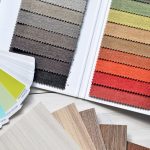Chinos are made from cotton twill, a durable yet comfortable fabric with a distinctive diagonal weave. This fabric resists wrinkles, stretches slightly, and breathes well, keeping you comfortable all day. You’ll find chinos in various weights—from lightweight for warm weather to heavier styles for cooler days—and sometimes blended with polyester or stretch fibers for extra durability and flexibility. Understanding these fabrics will help you grasp why chinos blend style and function so well.
Table of Contents
Key Takeaways
- Chinos are primarily made from cotton twill, a durable fabric with a distinct diagonal weave providing strength and a soft texture.
- Cotton twill offers wrinkle resistance, breathability, and flexibility, making it ideal for comfortable daily wear.
- Chino fabric varies in weight, with lighter options (6-8 oz) for warm weather and heavier ones (10-12 oz) for cooler seasons.
- Modern chinos often use blended fabrics like cotton-polyester or stretch materials for enhanced durability and flexibility.
- Proper care, including cold washing and gentle drying, preserves the fabric’s strength, color, and texture for long-lasting chinos.
History of Chino Fabric
Although you might wear chinos without thinking about their origins, the fabric has a rich history dating back to the 19th century.
You’ll find that chinos were originally designed for British and French military uniforms. Soldiers needed durable, comfortable pants suitable for warm climates, so manufacturers created a fabric that balanced strength and breathability.
The name “chino” actually comes from the Spanish word for “Chinese,” referring to the fabric’s Asian roots.
Over time, what started as military wear shifted into civilian fashion, gaining popularity for its practical yet stylish appeal.
When you slip on chinos today, you’re wearing a piece of history that blends functionality with timeless style, crafted with a legacy that started on the battlefield and evolved into everyday wear.
Characteristics of Cotton Twill
Chinos owe much of their comfort and durability to cotton twill, the fabric that defines their character. When you touch cotton twill, you’ll notice its distinct diagonal weave, which gives it strength and a subtle texture.
This weave not only makes the fabric tough but also helps it resist wrinkles, keeping your chinos looking sharp throughout the day. Cotton twill feels soft against your skin, offering breathability that’s perfect for warmer weather.
You’ll appreciate how it balances sturdiness with flexibility, allowing for ease of movement without feeling stiff. Additionally, the fabric has a natural ability to absorb dyes evenly, giving your chinos a rich, consistent color.
Understanding these characteristics helps you see why cotton twill remains a popular choice for chino fabric.
Why Cotton Twill Is Ideal for Chinos
You’ll appreciate how cotton twill’s unique weave gives chinos their strength without sacrificing comfort.
This fabric stands up to daily wear while keeping you feeling breathable and flexible.
Understanding these qualities shows why cotton twill is the perfect choice for your favorite chinos.
Cotton Twill Characteristics
Cotton twill stands out for its durability and comfort, making it the perfect fabric choice for chinos.
You’ll notice its distinctive diagonal weave pattern, which not only adds a subtle texture but also strengthens the fabric. This weave helps resist wrinkles and stains, keeping your chinos looking sharp throughout the day.
Cotton twill also offers breathability, allowing air to circulate, so you stay comfortable whether you’re indoors or outside. Its medium weight strikes a balance, providing enough structure without feeling heavy or stiff.
Plus, cotton twill drapes nicely, giving your chinos a clean, tailored appearance. When you wear chinos made from cotton twill, you get a fabric that’s both practical and stylish, fitting effortlessly into your everyday wardrobe.
Durability and Comfort Benefits
The unique weave and breathable nature of cotton twill don’t just enhance the look of your chinos—they directly contribute to their long-lasting comfort and strength.
Because cotton twill is tightly woven, it resists wear and tear, making your chinos last through daily use and frequent washing. At the same time, its breathability keeps you comfortable by allowing air to circulate, preventing overheating.
The fabric also adapts well to your movements, offering flexibility without losing shape. This combination means your chinos won’t feel stiff or restrictive, even after hours of wear.
When you choose chinos made from cotton twill, you’re getting a balance of durability and comfort that few other fabrics can match. This makes them ideal for both casual and more active settings.
Variations in Chino Fabric Weight and Texture
Although chinos are often associated with a specific look, their fabric weight and texture can vary considerably, affecting both comfort and durability.
You’ll find lighter-weight chinos perfect for warmer weather, offering breathability and a softer feel. These typically weigh between 6 to 8 ounces per square yard, making them ideal for casual outings or office wear in spring and summer.
On the other hand, heavier fabrics, usually around 10 to 12 ounces, provide more structure and warmth, suitable for cooler months or rugged use.
Texture also shifts depending on the weave; smoother twills feel polished, while coarser weaves add ruggedness.
Understanding these variations helps you pick chinos that match your lifestyle and climate, ensuring you stay comfortable without sacrificing style.
Blended Fabrics Used in Modern Chinos
You’ll often find modern chinos made from a cotton-polyester blend that boosts durability without sacrificing comfort.
Stretch fabrics are also common, giving you greater flexibility and ease of movement throughout the day.
These blends help chinos hold up better while keeping you comfortable in any setting.
Cotton-Polyester Mix
Cotton-polyester blends combine the best qualities of both fibers, offering chinos that are durable, wrinkle-resistant, and easy to care for.
When you choose chinos made from this mix, you get the breathability and softness of cotton paired with polyester’s strength and shape retention. This means your chinos will maintain a neat appearance throughout the day without constant ironing.
They’re also less prone to shrinking or fading after washing, making them ideal for everyday wear. Plus, the blend improves moisture-wicking, so you stay comfortable even in warmer weather.
If you want chinos that combine comfort with practicality, cotton-polyester blends provide a smart balance, ensuring your pants look sharp and last longer with minimal upkeep.
Stretch Fabric Benefits
Blending fabrics doesn’t just improve durability and comfort—it can also add stretch to your chinos, making them more flexible and easier to move in.
When manufacturers include a small percentage of elastane or spandex alongside cotton, your chinos gain elasticity that lets you bend, sit, and walk without restriction. This stretch fabric adapts to your body’s movements, so you won’t feel confined, even during long days or active outings.
Plus, the added stretch helps your chinos maintain their shape over time, reducing sagging or bagging in key areas like knees and thighs.
If you value freedom of movement without sacrificing style, choosing chinos with stretch fabric can make a noticeable difference in your daily comfort and wearability.
Durability and Comfort
Although traditional cotton chinos offer comfort, modern blends elevate both durability and ease of wear.
When you choose chinos with blended fabrics, you get the best of both worlds—softness and strength. These blends resist wrinkles, fading, and tears better than pure cotton, so your chinos last longer and look sharp throughout the day.
Here’s what you’ll often find in modern chino blends:
- Cotton-polyester: Adds wrinkle resistance and durability.
- Cotton-spandex: Provides flexibility and stretch for comfort.
- Cotton-nylon: Enhances abrasion resistance and toughness.
- Cotton-elastane: Offers stretch and shape retention.
Differences Between Chino and Denim Fabric
When you compare chino and denim fabrics, you’ll notice they serve different purposes despite both being popular choices for casual wear.
Chino fabric is typically made from lightweight cotton twill, giving it a smooth, refined texture and a softer feel against your skin. Denim, on the other hand, is a heavier cotton twill woven with a diagonal ribbing, making it thicker and more rugged.
Chino is lightweight and smooth, while denim is heavier with a rugged, diagonal weave texture.
You’ll find chinos are more breathable and dressier, perfect for smart-casual settings. Denim’s durability and coarse texture lend themselves well to workwear and casual outfits.
While chinos offer a clean, polished look, denim provides a more casual, edgy vibe. Understanding these differences helps you pick the right fabric for your style and comfort needs.
How Fabric Choice Affects Chino Durability
Since fabric forms the foundation of any pair of chinos, your choice directly impacts their durability. Opting for the right fabric guarantees your chinos withstand daily wear and tear.
Here’s how fabric influences durability:
- Cotton twill – Known for its tight weave, it resists abrasions and holds up well over time.
- Fabric weight – Heavier fabrics last longer but might feel stiffer; lighter ones wear out quicker.
- Blended fibers – Adding synthetic fibers like polyester increases strength and wrinkle resistance.
- Finishing treatments – Some fabrics get special coatings that improve durability and color retention.
Breathability and Comfort of Chino Fabrics
Breathability plays an essential role in how comfortable your chinos feel throughout the day. Cotton, the primary fabric used in chinos, naturally allows air to circulate, keeping you cool and reducing sweat buildup.
When chinos are made from a lightweight cotton twill, they offer excellent ventilation, making them ideal for warmer weather. Blends that include a small percentage of synthetic fibers might reduce breathability slightly but can add stretch and shape retention.
You’ll notice that well-made chinos balance softness with airflow, guaranteeing they don’t cling to your skin. This breathability, combined with a smooth texture, makes chinos suitable for both casual and semi-formal occasions.
When you choose your chinos, pay attention to fabric weight and weave to guarantee maximum comfort throughout your day.
Caring for Your Chino Fabric Garments
Although chinos are durable, you’ll want to care for them properly to maintain their look and feel. Treating your chinos right extends their life and keeps their fabric fresh and comfortable.
Proper care preserves your chinos’ durability, keeping them looking sharp and feeling comfortable longer.
Here’s how to care for your chino fabric garments:
- Wash in cold water to prevent shrinking and color fading.
- Use a gentle cycle to protect the fabric’s weave and avoid wear.
- Avoid bleach and harsh detergents that can weaken fibers and dull colors.
- Air dry or tumble dry low to reduce fabric stress and maintain shape.
Following these steps guarantees your chinos stay crisp and comfortable, ready for any occasion.
Proper care keeps your investment looking sharp for longer.
Frequently Asked Questions
Can Chinos Be Made From Organic Cotton?
Imagine walking through a field of soft, green cotton clouds. Yes, you can wear chinos made from organic cotton—they blend comfort and eco-friendliness, letting you step lightly on the earth while looking sharp and feeling great all day.
Are Chinos Suitable for Formal Occasions?
You can wear chinos for semi-formal occasions since they offer a polished yet relaxed look. Just pair them with a crisp shirt and blazer, but avoid using them for very formal events like black-tie affairs.
How Do Chinos Fit Compared to Other Pants?
You’ll find chinos fit slimmer than traditional jeans but more relaxed than dress pants, offering 20% more comfort. They contour your legs without being tight, making them versatile for casual and smart looks alike.
Can Chino Fabric Be Dyed Different Colors Easily?
You can dye chino fabric different colors fairly easily because it’s typically made from cotton, which absorbs dye well. Just remember, the fabric’s weave and finish might affect how vibrant and even the color turns out.
Are There Eco-Friendly Alternatives to Traditional Chino Fabric?
Like finding a needle in a haystack, eco-friendly chinos use organic cotton, Tencel, or recycled fibers. You’ll reduce your footprint while staying stylish—these fabrics blend sustainability with comfort effortlessly.
- A Look Into the Luxury of Wool Sateen Suiting Fabric - June 21, 2025
- The Pros and Cons of Using Polyester Sateen Fabric - June 21, 2025
- What Is NYCO Sateen and Why Is It Used in Military Apparel? - June 21, 2025







